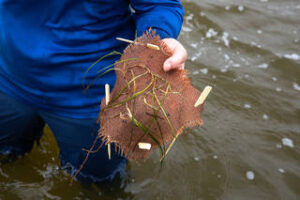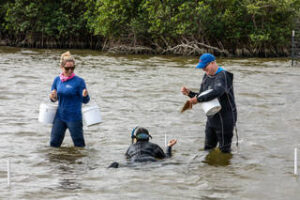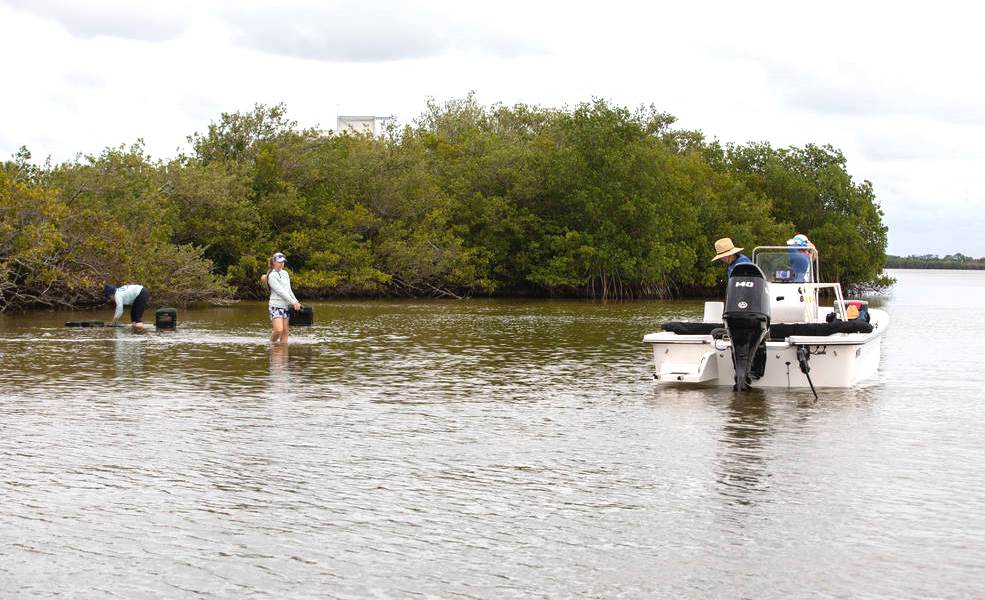Once home to the densest region of seagrass in Florida‘s Indian River Lagoon system, the Banana River at NASA’s Kennedy Space Center has recently become the focus of a pilot project for seagrass restoration efforts.
Ecological scientists at the Florida spaceport have been monitoring the amount of seagrass found in Kennedy’s waters since the early 1980s, and it had always been robust.

Seen here is a close-up view of one “plot” of seagrass being planted in the Banana River – one of three bodies of water that make up the Indian River Lagoon (IRL) – at NASA’s Kennedy Space Center on March 29, 2023.
“It was like carpet out here, it was gorgeous for years,” recalled Doug Scheidt, an ecologist working on NASA’s Environmental and Medical Contract (NEMCON) at Kennedy.
But in the 2010-2011 timeframe, the entire lagoon, which spans five counties and is 156 miles long, started to see massive losses of seagrass – especially in the northern area of the lagoon.
Scientists and researchers believe that declining water quality due to high nutrient input coupled with a series of long-term and larger-than-usual phytoplankton blooms started blocking out the sunlight, which is necessary for seagrass growth.
“It just shaded everything out. It’s kind of like throwing a tarp on your yard for a long time – if you did that, your grass wouldn’t be able to grow. Because seagrass is just that; it’s grass, and it needs light,” Scheidt said.
To address this and other environmental issues in the waters surrounding Kennedy, the spaceport’s Environmental Management Branch, in coordination with Merritt Island National Wildlife Refuge, Canaveral National Seashore, and Cape Canaveral Space Force Station, developed a lagoon Health Initiative Plan, which identifies potential projects and initiatives that would complement the waterway’s larger needs defined by the Environmental Protection Agency’s Indian River Lagoon National Estuary Program.
“They already had a list, what they call vital signs, of things that are important to the lagoon, and we matched our needs here to those so that we were enhancing what needed to be done lagoonwide in our area,” Scheidt said.
Part of that list focused on the recovery of seagrass, which provides a food source for manatees, turtles, and other herbivores and serves a structure for small fish to hide in while also improving water quality by stabilizing sediment.
Kennedy’s environmental team developed and initiated the pilot project to determine the feasibility of replanting seagrass in Kennedy waters.

Lorae Simpson (left), director of research and conservation with the Florida Oceanographic Society, and Doug Scheidt (right), an ecologist working on NASA’s Environmental and Medical Contract (NEMCON), begin planting seagrass in the Banana River – one of three bodies of water that make up the Indian River Lagoon (IRL) – at NASA’s Kennedy Space Center in Florida on March 29, 2023.
This includes planting a minimum of 28,000 shoots of seagrass divided into 18 sites across three areas at Kennedy.
Each “plot” of seagrass contains 16 shoots tied to a burlap mesh square with floral ties and has bamboo skewers at each corner that are staked into the sediment. All these materials are biodegradable.
The seagrass was brought to Kennedy and planted by the Florida Oceanographic Society. Planting began March 28 and will continue through the next few weeks. In September, this team of researchers will return to see if the seagrass survived the growing season.
If successful, these sites at Kennedy could be used as donor areas, where shoots of grass can be broken off and relocated to other areas within Kennedy or along the lagoon to promote growth.
“NASA’s commitment to supporting this effort is heartening, it’s good,” said Jane Provancha, manager of the ecological group for NEMCON. “I’m very proud to work here where the agency wants to make commitments like this. But it’s a really hard road, and together with our local partners in lagoon restoration, we have a long way to go.”
In addition to working toward a healthy lagoon, Kennedy is committed to carrying out NASA’s mission while limiting other effects on the local environment.
Of the 140,000 acres the spaceport sits on, less than 5% is developed land to support America’s space program. The remaining acreage is left untouched to keep the integrity of the local wildlife and surrounding habitats.
“I like, hopefully, that we’re making an impact here,” Scheidt said. “That right there is my favorite view of the whole place, with all those palm trees and the VAB (Vehicle Assembly Building) popping up behind them. It’s such a unique place, and not many people get to see the beauty of it. It’s still fairly undisturbed, so we want to protect it as best we can.”
All photos are courtesy of NASA / Kim Shiflett. In the featured photo, members of the Florida Oceanographic Society collect mats of seagrass from their storage site at NASA’s Kennedy Space Center in Florida as they prepare to plant them in the Banana River – one of three bodies of water that make up the Indian River Lagoon (IRL) – on March 29, 2023. Kennedy’s Environmental Management Branch is working to plant a minimum of 28,000 shoots of seagrass divided into 18 sites across three areas at the Florida spaceport as part of a pilot project for seagrass restoration efforts.

